How to Grow a Thriving Rose Garden
- February 9, 2024
- 0 comment
Discover the beauty and secrets of rose gardening. Learn expert tips for growing and caring for a rose garden that thrills the senses. Roses, with their intricate petals and enchanting fragrances, hold a special place in the hearts of gardeners and flower enthusiasts alike. Beyond their aesthetic appeal lies a deep reservoir of history, symbolism, and the art of cultivation that many are yet to discover. This guide provides expert tips for growing and caring for a rose garden, designed to engage the senses and enhance your outdoor space.
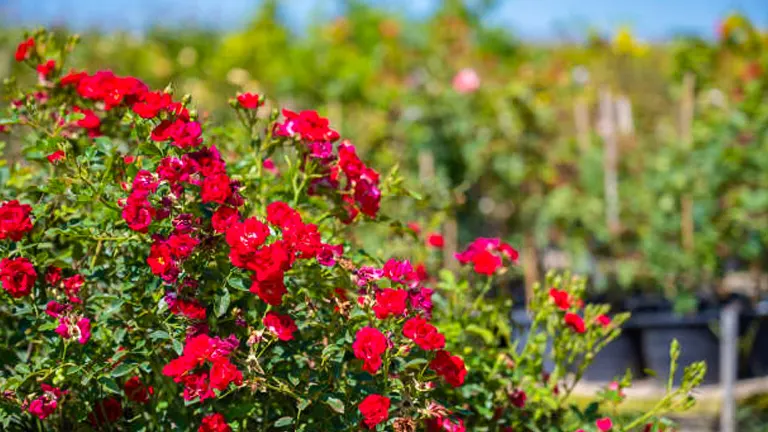
Whether you’re starting from scratch or looking to improve your existing garden, our practical advice aims to equip you with the knowledge needed to cultivate a thriving and visually appealing rose garden. Join us as we delve into the essentials of rose care, offering straightforward strategies for gardeners of all levels.
Table of Contents
- Understanding Roses
- How to Grow a Thriving Rose Garden: A Comprehensive Guide
- Comprehensive Care for Thriving Roses
- Designing with Roses
- Advanced Propagation Techniques
- Environmental Benefits of Rose Gardening
- Protecting Roses from Pests and Diseases
- Conclusion
- FAQs
Understanding Roses
Diversity in the Rose Family
The world of roses is vast and varied, boasting over three hundred species and thousands of hybrids. Each variety, from the robust Hybrid Teas to the charming Old Garden Roses, brings its own set of characteristics and needs. Understanding the diversity within the rose family is the first step towards selecting the right roses for your garden. Considerations such as bloom time, fragrance, and disease resistance play critical roles in this choice.
Common Species of Roses
Gallica Roses (Rosa gallica)
Gallica Roses (Rosa gallica) are historic, fragrant flowers with deep pink to purplish red blooms, ideal for compact garden spaces.

- Color Range: Shades of pink, deep purples, and maroon.
- Size: 2-4 feet in height and width, making them compact enough for small gardens.
- Fragrance: Strong and sweet.
- Hardiness Zones: USDA zones 4 through 8.
- Special Features: Disease-resistant and low maintenance. Ideal for borders and flower beds.
Damask Roses (Rosa damascena)
Damask Roses (Rosa damascena) are cherished for their exquisite fragrance and beautiful pink to light red blooms, essential in perfumery.
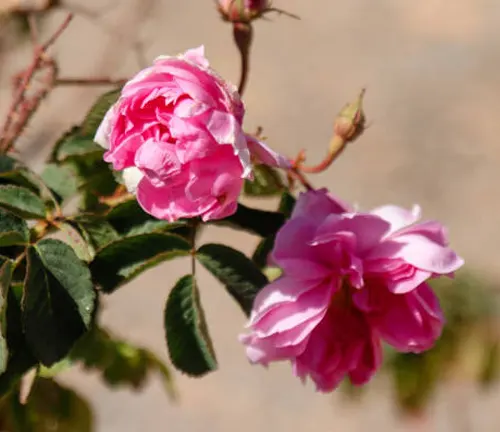
- Bloom Time: Late spring to early summer; some varieties offer a second bloom in late summer.
- Color Range: Mainly light to deep pink and some whites.
- Size: Can grow up to 7 feet tall, depending on the variety.
- Fragrance: Intensely fragrant, used in perfumery.
- Hardiness Zones: USDA zones 4 through 9.
- Special Features: Used historically for rose oil and rose water. Requires full sun and well-drained soil.
Cabbage Roses (Rosa centifolia)
Cabbage Roses (Rosa centifolia) are known for their full, lush blooms and sweet fragrance, reminiscent of vintage gardens.

- Color Range: Primarily pink, with some varieties offering white and light red.
- Size: 5-6 feet in height, with a similar spread.
- Fragrance: Strong, sweet, and classic rose scent.
- Hardiness Zones: USDA zones 4 through 7.
- Special Features: Dense, lush petals giving a “cabbage” appearance. Prefers rich, well-drained soil and ample water.
Rugosa Roses (Rosa rugosa)
Rugosa Roses (Rosa rugosa) are hardy, disease-resistant shrubs known for their wrinkled leaves and large, fragrant blooms.
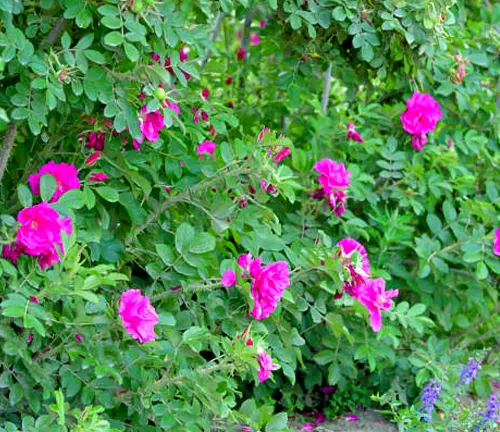
- Bloom Time: Repeatedly from late spring through fall.
- Color Range: White, pink, and red.
- Size: 4-6 feet tall and wide, with a rugged, bushy growth habit.
- Fragrance: Moderate to strong, with a pleasant scent.
- Hardiness Zones: USDA zones 2 through 9.
- Special Features: Highly disease-resistant, salt-tolerant, making it suitable for coastal gardens. Known for its attractive, wrinkled foliage and large, colorful hips in autumn.
China Roses (Rosa chinensis)
China Roses (Rosa chinensis) are notable for their continuous blooming, vibrant colors, and significant influence on modern rose hybrids.
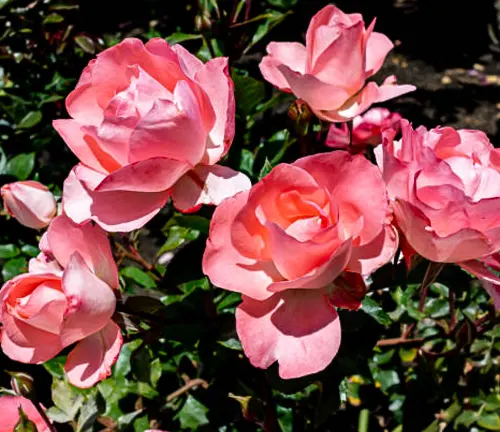
- Bloom Time: Repeatedly from late spring to frost.
- Color Range: Includes pinks, reds, whites, and yellows.
- Size: Varies widely from 2 feet shrubs to climbers over 6 feet.
- Fragrance: Mild to strong, depending on the variety.
- Hardiness Zones: USDA zones 6 through 9.
- Special Features: Known for their ability to bloom multiple times in a single season, China roses are ancestors of many modern hybrid teas and floribundas. They require well-drained soil and a sunny position.
Lady Banks’ Rose (Rosa banksiae)
Lady Banks’ Rose (Rosa banksiae) is a vigorous, thornless climber known for its profuse, small, and fragrant spring blooms.
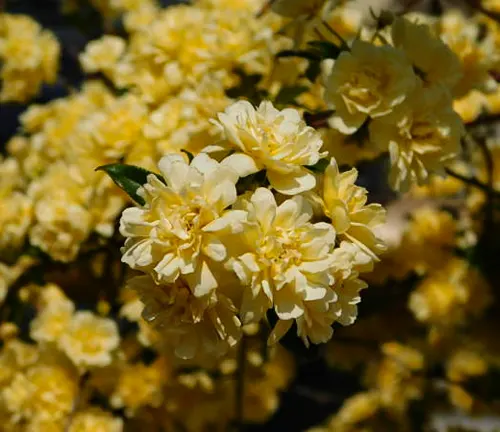
- Bloom Time: Early spring.
- Color Range: Primarily white and yellow.
- Size: Can climb 15 to 20 feet or more.
- Fragrance: Light and sweet.
- Hardiness Zones: USDA zones 7 through 9.
- Special Features: Thornless and vigorous, Lady Banks’ rose is ideal for covering fences or walls. It’s known for its small, double flowers that appear in clusters.
The History and Symbolism of Roses
Roses hold a revered place in history, symbolizing everything from love and beauty to war and politics. The ancient Romans used roses to lavish their banquets and civic ceremonies, while in medieval times, roses adorned royal crests and battlefield standards. Recognizing the rich symbolism of roses adds a layer of depth to the gardening experience, connecting us with the past and the varied meanings these flowers have carried through the ages.
How to Grow a Thriving Rose Garden: A Comprehensive Guide
Step 1: Selecting the Right Rose Varieties

- Research and Choose Wisely: Begin by understanding the vast array of rose types available. Hybrid Teas are celebrated for their singular, large blooms per stem, while Floribundas produce multiple smaller blooms in clusters. Climbers and Ramblers are perfect for vertical accents, and Shrub roses offer disease resistance and hardiness for landscape use. Select varieties that match your garden’s climate, soil conditions, and aesthetic goals.
- Disease Resistance: Prioritize varieties known for their resilience to diseases like rust, black spot, and powdery mildew. This foresight can significantly reduce maintenance efforts and chemical interventions later on.
Step 2: Site Selection and Preparation
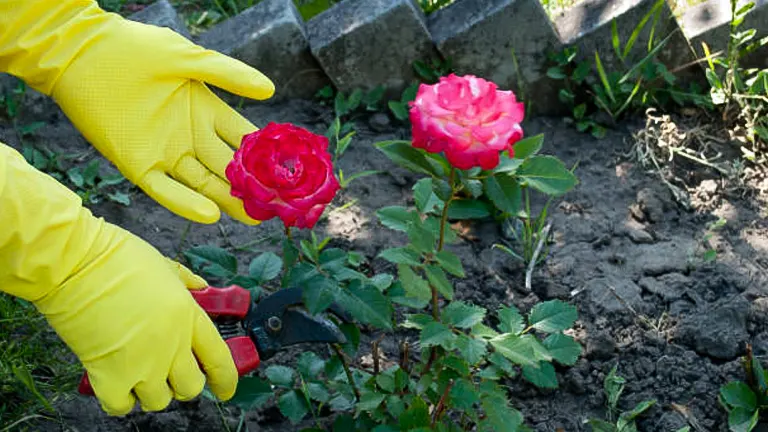
- Sunlight and Space: Roses flourish in locations receiving full sun (6-8 hours daily) and well-circulated air. Avoid spots shadowed by larger trees or buildings to prevent blooms from being sparse.
- Soil Readiness: Roses thrive in rich, well-draining soil with a pH between 6.0 and 6.5. Amend your garden soil by mixing in generous amounts of compost or aged manure to improve nutrient content and structure. If drainage is a concern, consider raising beds to ensure water does not pool around roots.
Step 3: Planting Techniques

- Timing: The ideal planting times are spring or fall, avoiding the extremes of summer heat and winter cold. This timing allows roots to establish before stress periods.
- The Planting Process: Dig a hole about twice as wide and as deep as the root ball. If grafted, position the bud union (where the graft meets the rootstock) just above the soil level in warm climates or 1-2 inches below in colder areas to protect it from frost. Fill the hole with a mix of garden soil and compost, firming gently around the roots. Water thoroughly.
Step 4: Watering and Mulching

- Watering Schedule: Early morning watering is recommended to allow foliage to dry before nightfall, reducing disease risk. Aim for deep watering that reaches the root zone, encouraging deeper root growth.
- Mulching Benefits: Mulch conserves moisture, keeps roots cool, and adds organic matter as it decomposes. Apply a 2-3 inch layer around roses, leaving space around the stem to prevent rot.
Step 5: Fertilization Strategy
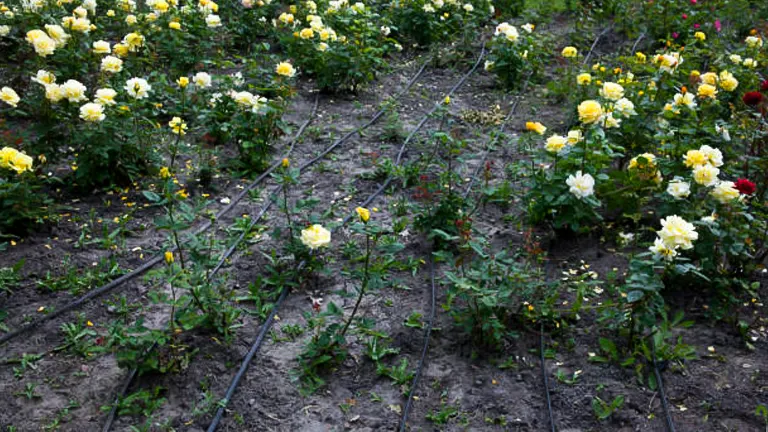
- Nutritional Needs: Start fertilizing when new growth appears, using a balanced rose fertilizer. Continue every 4-6 weeks through the end of summer. Cease fertilization approximately 6 weeks before your area’s first frost date to prevent new growth that could be damaged by cold.
- Organic Options: For those preferring organic gardening, amendments like fish emulsion, bone meal, and composted manure are excellent sources of nutrients for roses.
Step 6: Pruning for Health and Beauty
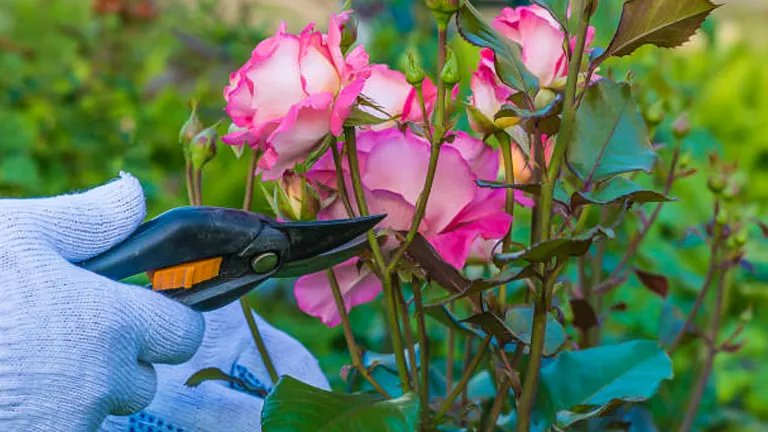
- Pruning Time: Late winter to early spring, before the plant breaks dormancy, is ideal for pruning. This timing encourages healthy, vigorous growth.
- How to Prune: Remove dead or diseased wood first, then thin out the center to improve air flow. Cut back remaining canes by about one-third, making cuts at a 45-degree angle just above outward-facing buds to direct growth outward and prevent crowding.
Step 7: Pest and Disease Management
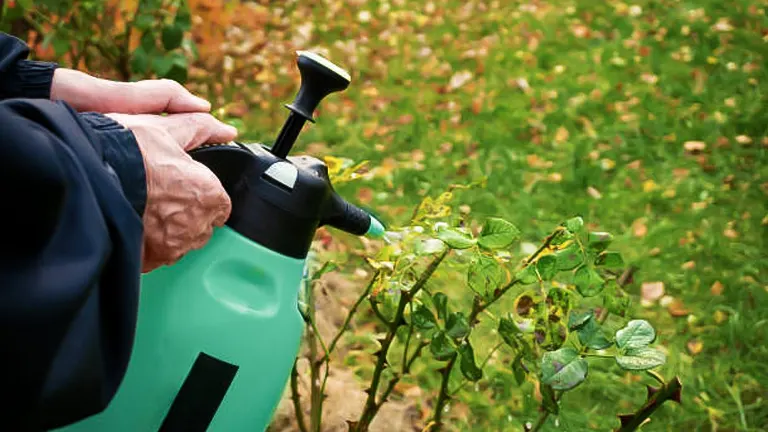
- Regular Monitoring: Keep an eye out for common pests like aphids, spider mites, and Japanese beetles, as well as signs of diseases such as black spot, rust, and powdery mildew.
- Integrated Pest Management (IPM): Employ cultural, mechanical, biological, and chemical strategies in a targeted, environmentally sensitive manner. For example, encourage beneficial insects, use neem oil or insecticidal soap for outbreaks, and remove diseased foliage promptly to prevent spread.
Step 8: Winter Care
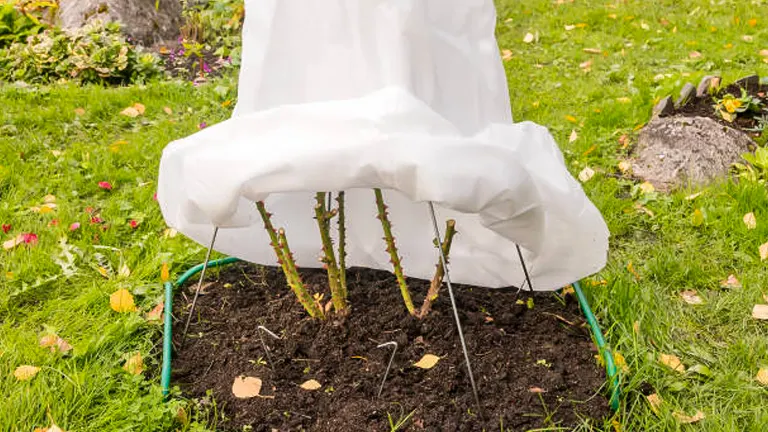
- Protection Measures: In colder zones, apply extra mulch around the base of roses after the ground freezes to protect roots and lower stems. For grafted roses, consider hill up soil or mulch around the graft union for added protection.
- Climbers and Standards: These may need special care, such as wrapping or using protective structures, to survive harsh winters.
Step 9: Enjoying and Sharing Your Garden
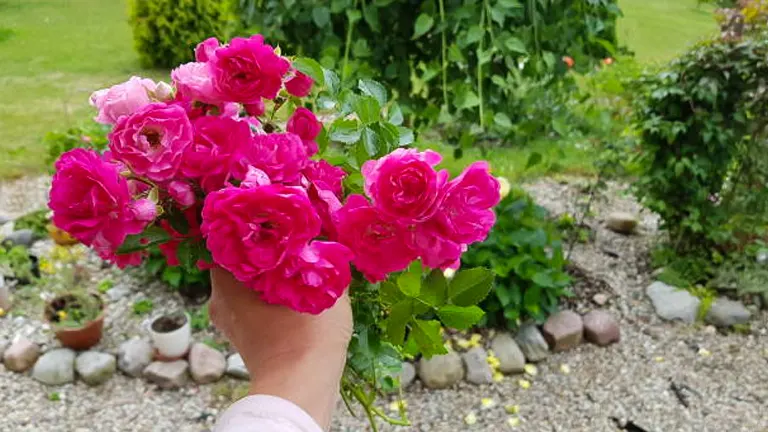
- Harvest Blooms: Cut roses in the early morning when their water content is highest for longer-lasting cut flowers. Use sharp, clean pruners and cut above a five-leaflet leaf to encourage re-blooming.
- Community Engagement: Join local gardening clubs or online forums to share experiences, get advice, and exchange varieties with fellow rose enthusiasts.
Comprehensive Care for Thriving Roses
Watering Wisely
Water is crucial for roses, but its application requires balance. Overwatering can lead to root rot, while underwatering stresses the plants. Aim for deep, infrequent waterings that encourage roots to grow deeper, enhancing drought resistance. Early morning is the best time to water, reducing evaporation and preventing leaf diseases. During hot, dry periods, roses may need water twice a week, whereas in cooler, wetter conditions, less frequent watering is necessary.
Feeding for Optimal Health and Blooms
Roses are hungry plants that thrive on nutrients to support their vigorous growth and prolific blooms. A balanced, slow-release fertilizer applied in early spring and again in midsummer provides the essential nutrients roses need. Organic options, like fish emulsion or composted manure, can also enrich the soil and promote healthy growth. Remember, over-fertilizing can harm your plants, so follow product guidelines carefully.
Pruning for Beauty and Vigor
Pruning not only shapes the rose bush but also encourages fresh growth and larger blooms. The best time to prune is late winter or early spring, just as buds begin to swell. Remove dead or diseased wood, thin out crowded areas to improve air circulation, and cut back remaining canes by about one-third to one-half to promote healthy new growth. Each cut should be made above a bud facing outward to direct the new growth outward.
Designing with Roses
Integrating Roses into Garden Designs
Roses can be the centerpiece of a garden design or part of a mixed border that includes perennials, shrubs, and annuals. When planning a rose garden, consider the height, color, and bloom time of different rose varieties to create a harmonious and visually appealing display. Climbing roses can add vertical interest to walls and pergolas, while miniature roses are perfect for borders and containers. Remember, the goal is to complement the garden’s overall design aesthetic while ensuring roses are planted in optimal conditions for sunlight and air circulation.
Color Schemes and Textural Contrast
Color plays a significant role in garden design. Roses offer a palette ranging from subtle whites and pastels to vibrant reds and yellows. Consider using color to create mood or highlight areas of the garden. Textural contrasts can be achieved by pairing the delicate petals of roses with the coarse foliage of companion plants like lavender or sage, adding depth and interest to your garden.
Companion Planting for Healthy Roses
Companion planting can enhance the beauty and health of your rose garden. Certain plants can deter pests, attract beneficial insects, or improve soil health. Marigolds, for example, can repel nematodes, while alliums deter aphids. Companion planting also maximizes space and ensures a fuller, more vibrant garden throughout the growing season.
Advanced Propagation Techniques
Expanding Your Rose Collection: Propagation allows gardeners to expand their rose collection and share these beloved plants with friends and family. While roses can be grown from seeds, most gardeners prefer methods like cuttings, grafting, or layering, which preserve the characteristics of the parent plant.
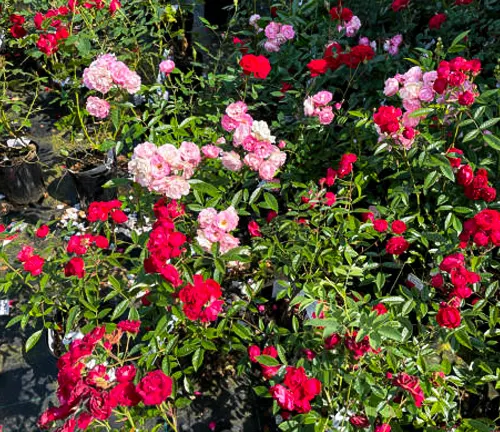

Cuttings: Taking cuttings is a simple and effective way to propagate roses. Choose healthy, non-flowering stems, cut them into segments, and plant them in a mixture of sand and peat moss. With proper care, these cuttings will root and grow into new plants.
Grafting and Layering: Grafting involves joining a piece of a desired rose variety to a hardy rootstock, promoting vigorous growth and disease resistance. Layering, on the other hand, encourages a stem to root while still attached to the parent plant, producing an exact clone of the original rose.

Environmental Benefits of Rose Gardening
1. Enhancing Garden Biodiversity with Pollinator-Friendly Roses
- Pollinator Support: Roses, especially those with open, single-layered blooms, serve as important nectar and pollen sources for bees, butterflies, and other pollinators. This interaction plays a crucial role in supporting garden ecosystems.
- Recommended Varieties:
- Rosa rugosa: Known for its resilience and simple, yet attractive flowers that appeal to a wide range of pollinators.
- Rosa ‘Gertrude Jekyll’: Admired for its rich fragrance and ample pollen, it is a magnet for bees.
- Rosa ‘Complicata’: Offers large, single blooms that provide easy access for pollinators, contributing to biodiversity.
2. Soil Stabilization and Erosion Control with Hardy Roses
- Preventing Soil Erosion: Roses with deep root systems and vigorous growth habits are excellent for stabilizing soil and preventing erosion, particularly on slopes and banks.
- Effective Varieties for Soil Stabilization:
- Ground Cover Roses (e.g., Rosa ‘The Fairy’): Low-growing and spreading, these roses cover ground quickly, anchoring soil effectively.
- Shrub Roses (e.g., Rosa ‘Bonica’): Their dense growth and robust root systems make them ideal for controlling erosion while adding beauty to challenging areas.
3. Creating Microhabitats for Wildlife
- Shelter and Food: Dense rose plantings can provide essential shelter and supplementary food sources for various wildlife species, from birds to beneficial insects.
- Natural Pest Control: By attracting beneficial insects, roses can play a part in natural pest management, reducing the need for chemical interventions in the garden.
4. Improving Air Quality and Carbon Sequestration
- Air Purification: Plants, including roses, contribute to cleaner air by absorbing carbon dioxide and releasing oxygen. The foliage of roses can also trap dust and pollutants, helping to improve air quality.
- Carbon Sequestration: Through photosynthesis, roses capture carbon dioxide from the atmosphere, storing carbon in their biomass and soil, contributing to the mitigation of climate change.
5. Supporting Water Conservation Efforts
- Reduced Runoff: The root systems of roses help to increase soil permeability, reducing water runoff and allowing more water to infiltrate the soil, which is beneficial for groundwater recharge.
- Drought-Tolerant Varieties: Selecting drought-resistant rose varieties can reduce water use in gardens, contributing to water conservation efforts.
Protecting Roses from Pests and Diseases
Common Pests and Diseases in Rose Gardens
Roses can be susceptible to a variety of pests and diseases, including aphids, spider mites, black spot, and powdery mildew. Regular monitoring is key to early detection and control. For pests, a strong jet of water or insecticidal soap can be effective treatments. For diseases, removing affected leaves and ensuring good air circulation around plants can prevent the spread.
Integrated Pest Management (IPM) for Roses
IPM emphasizes using the least toxic methods to manage pests and diseases, focusing on prevention, cultural practices, and biological controls before resorting to chemicals. Encouraging beneficial insects, such as ladybugs and lacewings, helps keep pest populations in check naturally.
Seasonal Care Strategies
Adjusting your rose care through the seasons ensures they remain healthy and vibrant year-round. In spring, focus on pruning and fertilizing to support new growth. Summer care includes regular watering, feeding, and pest and disease monitoring. Prepare roses for winter by gradually reducing water in the fall and applying a protective layer of mulch around the base of each plant to insulate roots.
Conclusion
Cultivating a rose garden is a labor of love, requiring attention, patience, and a bit of skill. By understanding the diverse needs of roses, preparing your garden correctly, and adhering to best practices in care and pest management, you can create a stunning rose garden that thrives for years to come. Whether you’re a novice or an experienced gardener, the journey of growing roses offers endless beauty and satisfaction, revealing the secret life of these enchanting blooms in all their glory.
FAQs
- What’s the optimal time to plant roses?
Plant roses in early spring after the last frost or in late fall, at least six weeks before the first expected frost, depending on your climate. - How do I select the right rose varieties for my garden?
Choose varieties that suit your climate (considering hardiness zones), garden conditions (sun exposure, space, soil type), and personal preferences (color, fragrance, type). Research and consult local nurseries for recommendations. - What are the sunlight requirements for roses?
Roses require at least 6-8 hours of direct sunlight daily. Full sun exposure ensures the healthiest growth and bloom production. - How often should roses be watered?
Water roses deeply but infrequently to encourage strong root systems, usually 1-2 inches per week, adjusting based on weather conditions. Avoid overhead watering to minimize disease risk. - What’s the best way to prepare the soil for planting roses?
Incorporate organic material such as compost or aged manure to enrich the soil. Ensure the soil has good drainage and a pH between 6.0 and 6.5. - How do I fertilize roses for optimal growth?
Use a balanced, slow-release fertilizer designed for roses in early spring as new growth appears, and again in midsummer. Avoid fertilizing late in the season to prevent new growth that could be damaged by frost. - When and how should roses be pruned?
Prune roses in late winter or early spring before new growth starts. Remove dead or diseased wood, thin out crowded areas, and shape the plant to encourage open growth and air circulation. - How can I protect my roses from pests and diseases?
Practice preventive care by selecting disease-resistant varieties and maintaining good garden hygiene. Use natural or recommended treatments for specific pests and diseases, and always follow integrated pest management practices.
With these steps in hand, you’re well on your way to nurturing a rose garden that blooms with vigor and beauty. Let each flower be a testament to the care and passion you invest in your garden. Enjoy the journey and the blooms that await.

Benjamin Brooks
Forestry AuthorGreetings! I'm Benjamin Brooks, and my journey over the past 15 years has revolved around the fascinating realms of content creation, expertise in snow clearing, and the intricate world of lumberjacking and landscaping. What began as a simple curiosity about the natural world and heavy machinery has evolved into a passionate profession where my love for crafting words intertwines seamlessly with my lumberjacking and garden skills.









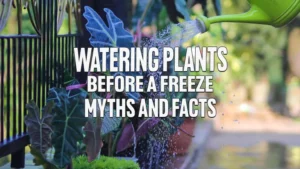


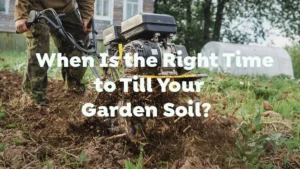
Leave your comment